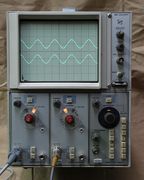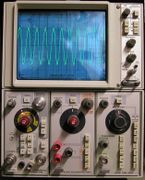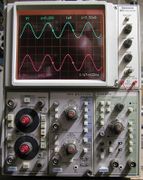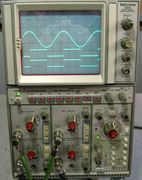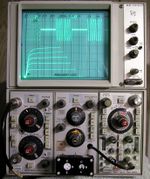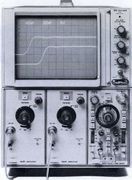5000-series scopes
Tektronix 5000-series scopes are described on the iceNINE Tech webpage.
See also Category:5000 series scopes
Introduction to the 5000-Series Oscilloscopes
The Basics of the 5000-Series
The 5000-series (5K) was introduced in 1971 as lower-cost, laboratory oscilloscope instrumentation with plug-in versatility. This series generally has larger display screens than the more-expensive and higher-performance 7000-series, but also has very low bandwidth in comparison.
Unlike other Tektronix products other than the 7704A in the 7000-series, the 5000-series mainframes consist of an acquisition unit (the 5103 or 5403) containing the plug-in compartments and low-voltage power supply and a display unit (e.g., the D10, D11, D12, D13, etc.). The idea was that the display unit could be sold separately for custom integrated uses by other manufacturers at a lower cost than could be had by using one of the 600-series monitors, and at the same time provide a larger display screen area. Within the Tektronix product line, the D10 and D11 display units are used in constructing the 577 semiconductor curve tracer, one providing a non-storage display and the other providing bi-stable storage.
But within the 5000-series, this led to documentation problems as each oscilloscope ended up with two model numbers and two serial numbers. In 1977, the scopes that were listed as “5103/D13” for example, with a serial number for each half, Tek began eliminating the serial number from the 5103 or 5403 portion, using the serial number from the display unit as the serial number for the complete oscilloscope. With this, Tek began referring to the various models with the acquisition unit prefix followed by the “D” number, such as 5110 for a 5103/D10, 5113 for a 5103/D13 or 5441 for a 5403/D41. Thus, documentation became much simpler.
Tektronix Service Centers began “grandfathering” this designation with the older models that had serial numbers on the acquisition unit, referring to them as the combined number (e.g., 5112) with the display's serial number, ignoring the serial number of the acquisition unit.
Unfortunately, all of this causes confusion today as service and operator's manuals are available for the 5103, D10, and 5110. In all cases, if you have the 5110 manual, you have all the operation and service information you need for that model. It will be pointless and take a lot more time, energy and money to find separate manuals for a 5104 and a D13 than it will be to find a 5113 manual.
Mainframe and Plug-In Numbering Convention
While the 7000-series has a certain convention for numbering the mainframes, the 5000-series has very little convention. The beginning “51” designates the 5100-series while “54” designates the 5400-series. After that, there is no convention as all are three-compartment mainframes which eliminates anything special that would be attributed to the last digit of the model number. The 10, 12, 13, 14, 15 and 16 that follow the “51” have no special meaning at all. Some are non-storage, some are bi-stable storage, some are dual-beam, some are both dual-beam and storage.
Here is a listing of mainframes and their capabilities:
- 5110 Single beam, non-storage
- 5111 Single beam, split-screen bi-stable storage
- 5111A Single beam, split-screen bi-stable storage (updated circuitry), 50 DIV/µs writing rate
- 5112 Dual beam, non-storage
- 5113 Dual beam, split-screen bi-stable storage, 20 DIV/µs writing rate
- 5114 Aha!! Tektronix never made a 5114! Who knows why they skipped over it to the 5115?
- 5115 Single beam, split-screen, bi-stable storage (>200 DIV/µs writing rate)
- 5116 Single beam, tri-color display using a LCD shutter.
- 5223 Single beam, digital storage
- 5440 Single beam, non-storage
- 5441 Single beam, variable-persistence storage
- 5444 Full dual beam (independent horizontal deflection systems using the 5B44 timebase)
(Option 3 enhances the writing rates to 200 DIV/µs on most 5100-series storage mainframes.)
5000-series plug-in numbering coincides more with that of the 7000-series. The first digit, a “5”, designates the plug-in as being for use in a 5000-series instrument. Unfortunately, there is no standard indication of whether or not it is compatible with the 5400-series. The second digit marks the general use of the plug-in. “A” units are preamplifiers; “B” units are timebases; “CT” designates curve tracers; “D” marks digital instruments; “L” is used to denote spectrum analyzers; and “S” denotes sampling plug-ins. The last two digits, however, depart from any standardization. It would have been nice for preamps to have a 1, 2 or 4 to denote number of channels for the third digit and then use the last digit to denote function, such as differential. But the last two digits are meaningless other than to differentiate one plug-in from another. The timebases are the same way, so there is no point of any further discussion.
The Two Faces of 5K and Compatibility
The 5000-series is divided into two general categories: the low-frequency 5100-series and the high-frequency 5400-series. The 5100-series has a maximum mainframe bandwidth of 2 MHz and lower bandwidths may be inflicted with plug-ins such as the 5A22N. The 5400-series has a maximum mainframe bandwidth of 60 MHz, again this figure at the mercy of lower-bandwidth plug-ins.
The lower-bandwidth plug-ins designed for the 5100-series (commonly referred to as “5100-series plug-ins) are the preamplifiers with suffix numbers of “2x” and lower, such as the 5A22N, 5A15N or 5A13N. Timebases for this series will have suffixes of “1x” and lower, such as 5B10N or 5B12N. In addition the 5CT1N semiconductor curve tracer, 5L4N spectrum analyzer and 5S14N sampling unit are available for use in this series.
“N” at the end of any Tektronix model number indicates a unit that DOES NOT have on-screen readout capability. You'll find this designation with all of the low-bandwidth plug-ins, but for some reason, none of the 5100-series mainframes ever have the “N” designation even though they have no readout capability. The only 7000-series products without readout capability have this designation on everything: 7403N, 7603N, 7A18N, 7B53AN, etc. It is not known why the 5110, for instance, is not the 5110N. One must suppose that it's simply because NONE of the mainframes ever have or can have readout capability. But this doesn't explain why the low-bandwidth plug-ins, none of which have or can every have readout DO have the “N” designation, with the exception of the 5A21 and 5A22 which have a readout option for use in the 5400-series mainframes.
Three plug-ins of the 5000-series directly mirror “twins” in the 7000-series: the 5CT1N (7CT1N), 5A22N (7A22) and the 5A13N (7A13). Front panel layout and function ) of these “twins” are nearly identical, although the bandwidth of the 7A13 is significantly higher than its 5K counterpart. 5100-series plug-ins may be used in ANY (5100- or 5400-series) mainframe in the 5K series. They will severely limit the bandwidth of the 5400-series, but they offer capabilities to the 5400-series that the series would otherwise not have, considering the function of the 5A13N, 5A22N, 5CT1N, 5S14N and 5L4N.
The 5400-series has its own small set of plug-ins dedicated only to that series. The 5400-series plug-ins absolutely CANNOT be used in the 5100-series and in fact, have interface connector keyways plugged to prevent them from being seated into a 5100-series compartment. THESE KEYWAYS MUST NEVER BE REMOVED OR ALTERED.
The 5400-series plug-ins are those that have suffixes of “3x” and larger for the preamps and “4x” and larger for the timebases. There are no other standard plug-ins that are not preamps or timebases for the 5400-series with the exception of the 067-0680-00 mainframe normalizer calibration fixture.
At this point, one may be curious and wonder WHY the 5400-series plug-ins cannot be used in the 5100-series mainframes. A close look at the interface connector on both series will show that the 5400-series has two extra power supply voltages, ±15v on interface connector pins 6A & B. 5400-series plug-ins will not find those two supply voltages in a 5100-series mainframe, so will not operate correctly. Those two pins are otherwise unconnected in a 5100 scope and whether or not one could modify one by building a bipolar 15-volt supply for those two pins and actually get a 5400-series plug-in to work is an unanswered question. There is really not much point in doing such a thing.
TM500-Series/5000-Series Compatibility
The mechanical aspects of the TM500 line of modular instrumentation and those of the 5000-series are identical except for the interface connector keying. There has been an instance of a TM500 frequency counter installed in a 5000-series mainframe with the LED display bright and presumably active, as the photo illustrated for some items being sold on an on-line auction. But it is suspected that this image was “Photo-shopped” by the unscrupulous seller. This error had been pointed out to the seller by this potential buyer with no response from him.
Here is the mandate: TM500 INSTRUMENTS AND 5000-SERIES INSTRUMENTS ARE ABSOLUTELY AND TOTALLY INCOMPATIBLE WITH EACH OTHER. ATTEMPTING TO OPERATE ONE TYPE IN ANOTHER TYPE OF MAINFRAME WILL RESULT IN THE DESTRUCTION OF THE PLUG-IN, MAINFRAME OR BOTH.
Here are the details. In the 5000-series, all power supply voltages are developed by the mainframe and supplied to the plug-ins as regulated voltages: +5v, ±15v (5400-series) and ±30v. There are no power supply circuits other than supply decoupling and small zener regulators in the plug-ins.
On the other hand, the TM500-series power modules (the “mainframes”) supply AC and raw DC voltages to the compartments and no regulated voltages, and these voltages are not supplied on similar interface connector pins as the 5000-series. All of the power supply regulation control circuitry is inside the individual plug-in for customized voltages, since each plug-in instrument is a radical design departure from the other instruments. The power module also contains one NPN and one PNP power transistor for each compartment for use by the instrument installed as a power supply regulation component, a design to keep the heat out of the plug-in and in the power module where it can be properly dissipated. None of this is even similar with the 5000-series.
However, this writer, plagued with intense curiosity, wondered if a 5CT1N could be modified to operate in a TM500 power module as an independent curve tracer with an external display. After a lot of study and design work, it was discovered that such as thing could be done. But it took modification of nearly every interface connector pad, cutting scores of circuit board runs, adding scores of jumpers and designing a “piggy-back” circuit board with extra power supply, warning indicator and signal interface circuitry. It was done, the project was a success and it was self-designated the “CT501” a rogue, non-Tektronix product. In the near future, you should be able to find the documentation for this radical conversion project on the pages of Tekwiki. It is a very intensive and laborious project requiring a lot of attention to detail and a lot of patience, and there's still no guarantee that it will work because of differences in production runs of the 5CT1N circuit board. But this is all an attempt at an illustration to show how the two systems are not the least bit compatible.
Plug-Ins and Bandwidth
The 5100-series mainframes are limited to a bandwidth of 2 MHz. As low as that bandwidth is relative to the rest of the Tektronix product line (there have been probably less than a dozen scopes with lower bandwidth over the life of Tektronix), many of the plug-ins lower the system bandwidth even more! Full bandwidth of a 5100-series mainframe can be had only with the 5A15N, 5A18N and 5A19N. The other preamplifiers limit the system bandwidth to 1 MHz, even less if you use a 5A22N and selectively limit the upper frequency cutoff.
Some may think that this low bandwidth makes the 5100-series worthless. In reality, there are five things that make the 5100-series attractive and worth your investment of time and money. (1) Those that work in the low-frequency arena of audio sound systems, LF and VLF radio, mechanical transducers, hearing aids, etc. will find the lack of HF noise in the 5100-series to be a blessing; (2) the plug-in versatility of the 5100-series can be matched only by that of the 7000-series, and then at a far higher price in cost and complexity; (3) a large display screen, internal graticule and fine, sharp trace; (4) simple and easy troubleshooting and repair, usually involving no custom, complex and hard-to-find Tek ICs; (5) and three nice plug-ins: the 5CT1N semiconductor curve tracer, the 5L4N audio spectrum analyzer and the 5S14N sampling system give the 5100-series power that you can't find in any of Tek's portable scopes. The 5S14 increases the effective bandwidth of the system to around 1 GHz.
Some Interesting Notes
The dual-beam 5444 was offered for sale for just one catalog year at $3330 and then was gone! The 5B44 was a plug-in developed for the 5444 to allow access to BOTH sets of horizontal deflection plates for full dual beam operation similar to the 7844 or 566. This plug-in appeared in the same catalog as the 5444 (for $895) and stayed for a full five years, even though the 5444 was the only scope in which it would work correctly. By the time it was deleted from the catalog, the price had risen to $1020. It would be a good story to hear.
The 5CT1N semiconductor curve tracer was introduced in the 1972 catalog and the price slowly rose from $350 to 375 over four years. Then in 1976, the price shot from $375 to $600! The next catalog in 1977 increased it to $630 and then a year later in 1977, it dropped down to $510!
The cheapest Tektronix instrument on record is probably the 5A24N, a spartan preamplifier that originally sold for $25 in 1971! Ten years later, the price had risen to $160.
The Tektronix 5000 series includes the following scopes:
These scopes are compatible with 5000-series plug-ins.
